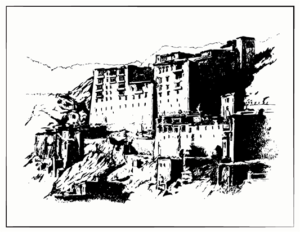 Ladakh and its history
Ladakh and its history
Ladakh is a portion of the wider Kashmir region that is administered by India as a union territory. It has been a source of contention between India, Pakistan, and China since 1947.
Before the Chinese government closed the border between Tibet Autonomous Region and Ladakh in the 1960s, foreign trade was down because Ladakh was at the centre of important trade lines. Since 1974, the Indian government has done a good job of getting tourists to visit Ladakh. Ladakh is important from a strategic point of view, so the Indian military keeps a big force there.Before the Chinese government closed the border between Tibet Autonomous Region and Ladakh in the 1960s, foreign trade was down because Ladakh was at the centre of important trade lines. Since 1974, the Indian government has done a good job of getting tourists to visit Ladakh. Ladakh is important from a strategic point of view, so the Indian military keeps a big force there.
After the Jammu and Kashmir Reorganisation Act was passed, Ladakh became a union territory of India on October 31, 2019. It had formerly been a part of the state of Jammu and Kashmir. The largest and second-least populated union territory in India is Ladakh.
History, Culture and Heritage of Ladakh
History of Ladakh
In the eleventh century AD, nomadic Khotanians invaded Ladakh and killed many people. Gyapacho defeated Khotan nomads with the help of Skide Nyimagon, Tibet’s last king’s son. Gyapacho gave him the unfamiliar Shey and Thiksey. Nyimagon, Ladakh’s first king, built Shey’s fortification and palace. He conquered Ladakh. Skide Nyimagon ruled the Nyimagon Dynasty from 975 to 1000. Ladakh had several kings between 1000 and 1500 AD. These rulers loved art. They built palaces and promoted religion.
Lodros Cholden (1435–1438 AD), Dragspa Bumlde’s son and successor, died or was imprisoned, ending Ladakh’s first dynasty. Lhachen Bhagan, Dragspa Bumlde’s son, inherited his uncle’s land, which encompassed Basgo and Teba (then upper and lower Ladakh). Bhagan (1460-1485) assassinated Leh King Lodros Choglden and disinherited his sons. Bhagan founded Ladakh’s second dynasty. Starting with his sons, Bhagan’s successors took the surname “Namgya”l, meaning “The Victor.” The first king of the new dynasty to be properly recorded was Tashi Namgyal, who ruled in the third quarter of the 16th century.King Tsewang Namgyal, who united Ladakh and established Leh its capital, is considered its greatest king.
King Jamnyang Namgyal (1595–1616 AD) promised Losar to aid the Tibetans fight the “Baltis” of Skardu. Jamyang Namgyal lost. Raja Ali Sher imprisoned you throughout the war. Jamnyang Namgyal married Ali Sher Khan’s daughter.Ladakh’s greatest ruler is their son Singay Namgyal. In 1638, he defeated a Mongol invasion of Guge and captured Tsaparang and Rudok. Zanskar and Upper Lahoul were annexed in 1630. He built Leh’s nine-story Namgyal palace and defeated Baltistan’s monarch. He built Hemis and Temisgam monasteries.
Buddhism & different sects in Ladakh
“Ratnagiri” claims Buddhism entered Ladakh via Kashmir.Ashoka dispatched 300 BC missionaries. Suru valley had Surendra viharas in the second century BC. Kushana empire was interested in Ladakh from 1st to 3rd century BC. Buddhism flourished in Kashmir and Ladakh under Kanishka in the early part of the second century. Stupas abound. Kanishka’s Kanika Stupa is in Zanskar. Buddhism struggled to gain a foothold in Tibet, which was dominated by the animistic and totemistic bon religion, in the mid-7th and 8th centuries. King Lang-Darma followed and protected this faith. He torched hundreds of Buddhist sacred texts and monasteries. King Tritsong Deotsen subsequently brought Guru Padmasambhava and monk Shaktarashita from India to restore harmony and put an end to these practices.
Guru Padmasambhava encountered several Bon practitioners who performed charms on him on his way to Tibet. Instead, he impressed them with his Tantric skills and swore local deities to serve and preserve the Buddha, Dharma, and Sangha. He created Tibet’s first Buddhist monastery at Samye and the first of four majiur schools of Tibetan Buddhism, “The Nyingmapa Schoo”. In thankas (scroll paintings) and walls, Guru Padmasambhava wears three monk robes and a red cap. Guru meditated in Ladakh his way to Tibet, leaving some markings. In some regions of Tibet and other countries, Bon, now substantially merged to Buddhism, is still practised. Ladakhis practise Mahayana and Vajrayana Buddhism. Mahayana, “The Greater Vehicle,” teachings aim to educate all creatures. Hinayana Buddhism emphasises self-enlightenment.
Different schools of Tibetan Buddhism ;
| Sect & period when it was founded. | First monastery or temple in ladakh | Head lama | Exponents | Major (under lined) and Associated monasteries |
| Nyingmapa (8th cent) | Taktok (8th century) | Guru Padmasambhava | Sakti | |
| Saskyapa (11th century) | Matho (15th century) | Atisha,Virupa, drokmi, Saskya Pandita etc | Matho (only) | |
| Kargyupa (11th cent) | Tilopa, Naropa, Marpa, Milarepa | |||
| Drigungpa (11th cent) | Phyang (1515) | Togldan Rinpoche | Chosje Denma kunga | Phyang &Lamayuru |
| Drukpa (12th century) | Hanle (17th century) | Incarnate if Lama Stagsang Raspa | Dugchen Rinpoche, Stagsang Raspa, | Hemis, stakna, Chemre,Shey,Sani, Zongkul etc |
| Gelukpa (14th century) | Spituk (14th century) | H.H.Bakula Rinpoche and Ngari Rinpoche(Lekir) | Atisha, Tsongkhapa, etc | Spituk,Lekir,Diskit, Thikse, Stakmo, Stok, Sankar, Alchi, Bazgo, Rizdong, Saspol, Karsha, Rangdum, Stongde ,Phugtal etc |

